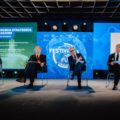
by Richard J. Heydarian
If there is a geopolitical hotbed potentially capable of triggering a truly global conflict, it is undoubtedly the South China Sea. This is where the unimaginable begins to resemble the inevitable, as a whole series of nations are unconsciously walking towards a ruinous showdown. Located in the heart of Asia, this hotly contested, resource-rich sea is not only a vital artery of international trade, through which nearly $ 5 trillion of goods pass each year, but also the epicenter of superpower rivalry. The South China Sea is where the parameters of the Sino-American "new cold war" they appear more evident and, consequently, deeply disturbing. Most importantly, this is where China's subliminal desire for supremacy is fully visible, with potentially dire consequences for its much smaller and extremely vulnerable neighbors.
The calm that precedes the storm
Until recently, the disputed stretch of sea was a relatively dark part of the world, surrounded by a coterie of apparently pacifist and decidedly mercantilist countries. With the end of the long Cold War, that in Asia cost millions of lives, economic development has become a real obsession with regional governance and national politics in the region. Singapore it has become a crucial hub for global trade, where trillions of dollars of goods arrive through the Straits of Malacca, while Thailand has transformed into the "Asian Detroit", churning out millions of cars for Japanese manufacturers. Meanwhile, Malaysia, Indonesia, Philippines and more recently also the Vietnam, have earned the nickname “Tiger cubs” after years of growth at above-average rates.
Meanwhile, post-Maoist China has experienced the largest capitalist expansion in human history, lifting hundreds of millions of people out of poverty within a single generation. On the wings of a new spirit marked by optimism and audacity, theAssociation of Southeast Asian Nations (ASEAN) is committed to creating a more inclusive, stable and prosperous order in the wider East Asian region.
ASEAN Regional Forum (ARF), for example, has provided an unprecedented platform for constructive and institutionalized dialogue between all the great powers, including the United States, China, Japan, India, Australia, the European Union and more recently also Russia. Thanks to the ASEAN Free Trade Area and the ASEAN Plus Three platform (which includes China, Japan and South Korea), this regional forum is increasingly convinced that it can create a Pan-Asian economy and a geopolitical bloc. The consequence of its strategic exuberance is the constitution of the much vaunted Regional Comprehensive Economic Partnership (RCEP), which includes 15 of the largest and most promising countries in the region, with the sole exception of India. It wasn't long before cracks began to form in this apparent climate of friendship and cooperation. The concatenation of various factors - the affirmation of popular nationalism and territorial revanchism, competition over precious energy resources and fisheries reserves, and the rapid rise of China which has undermined the regional balance of power - has transformed the deceptively calm waters of the South China Sea in a powder keg.






